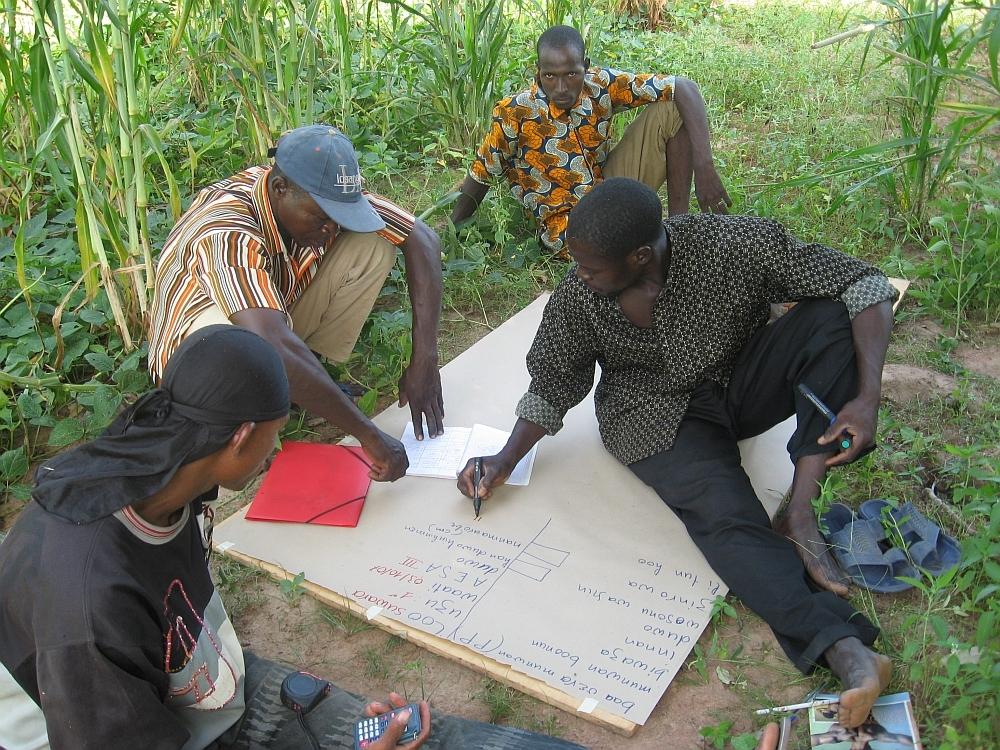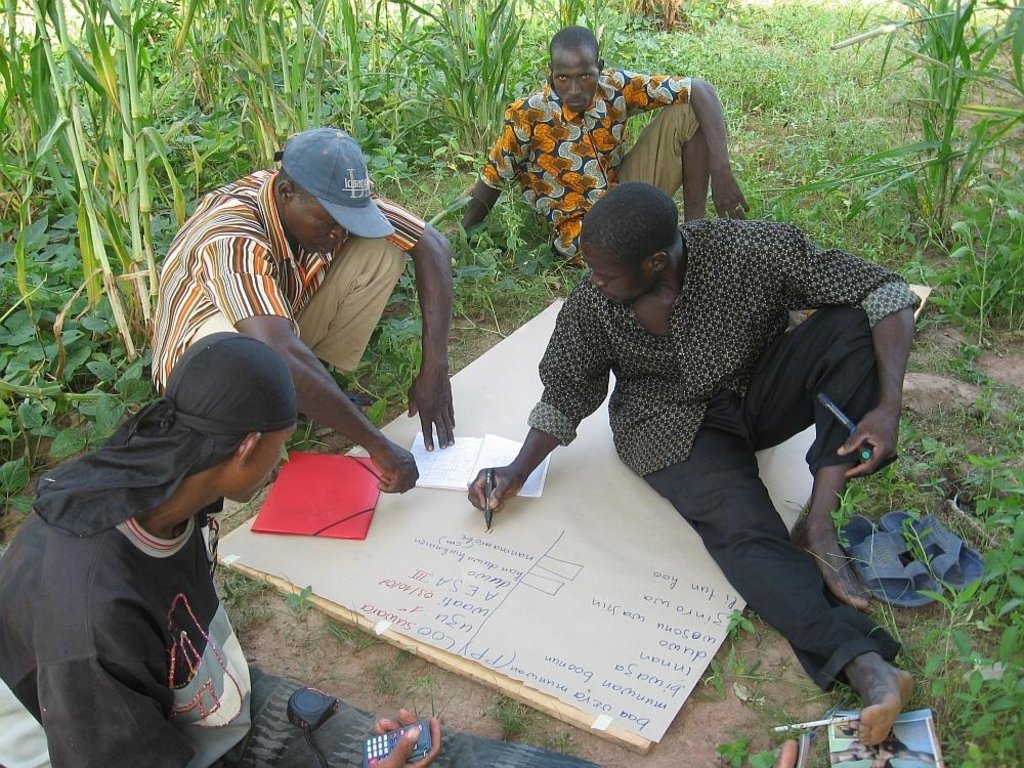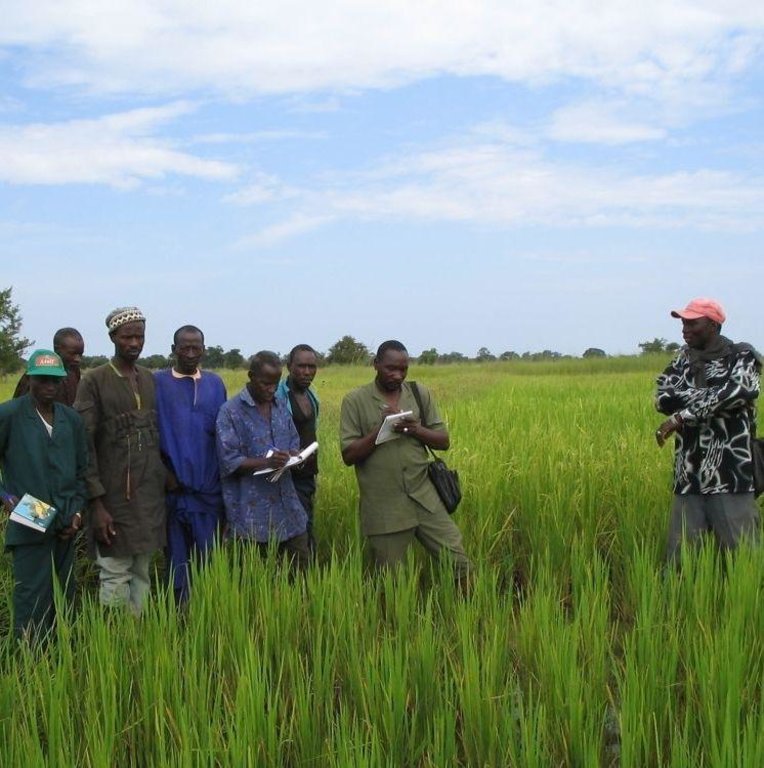Participatory Learning and Action Research for Integrated Rice Management (PLAR-IRM) [Mali]
- Criação:
- Atualização:
- Compilador/a: Dieter Nill
- Editor: –
- Revisor: Laura Ebneter
Apprentissage participatif/recherche-action pour la gestion intégrée du riz (French)
approaches_2502 - Mali
Veja as seções
Expandir tudo Recolher tudo1. Informação geral
1.2 Detalhes do contato das pessoas capacitadas e instituições envolvidas na avaliação e documentação da abordagem
Especialista em GST:
Guindo Idrissa
idrissa.guindo@helvetas.org
HELVETAS - Swiss Intercooperation
Mali
Especialista em GST:
Keita Lassana
lassana.keita@helvetas.org
HELVETAS - Swiss Intercooperation
Mali
Especialista em GST:
Dacko Maïga Rosaline
rosaline.dacko@helvetas.org
HELVETAS - Swiss Intercooperation
Mali
Nome da(s) instituição(ões) que facilitou(ram) a documentação/avaliação da Abordagem (se relevante)
Deutsche Gesellschaft für Internationale Zusammenarbeit (GIZ) - AlemanhaNome da(s) instituição(ões) que facilitou(ram) a documentação/avaliação da Abordagem (se relevante)
HELVETAS (Swiss Intercooperation)1.3 Condições em relação ao uso da informação documentada através de WOCAT
Quando os dados foram compilados (no campo)?
01/07/2012
O compilador e a(s) pessoa(s) capacitada(s) aceitam as condições relativas ao uso de dados documentados através do WOCAT:
Sim
2. Descrição da abordagem de GST
2.1 Descrição curta da abordagem
An approach to develop farmers’ capacities to observe and analyse their rice management and growing practices; and to identify major constraints, then test, adapt and innovate with ways to improve integrated rice management.
2.2 Descrição detalhada da abordagem
Descrição detalhada da abordagem:
This is an educational approach for farmers, based around training groups of 20 to 25 adults and drawing on the experience of the farmers participating in the group. Farmers undertake their own analyses of the problems at hand and find their own solutions.
The PLAR-IRM approach comprises the following stages: Farmers start out by exchanging their knowledge, opinions, experiences and practices with each other and then observe crop behaviours. They compare, interpret, analyse and understand the causes for the differences observed. Next they weigh up the actions to be taken, testing new ideas and then putting them into practice. Farmers organise themselves (individually and as a group or community) to undertake the activities. Following this, functional networks are created with other farmers, extension/research services and any other support service. During the process, farmers’ learning and understanding is facilitated so that they can make better and more informed decisions, with the end goal of more productive and sustainable integrated rice management. The animators/facilitators use the learning tools provided in the PLAR-IRM training modules. These tools have been developed primarily to encourage farmers to exchange their experiences and to observe, reflect, analyse, conceptualise and test as a group. Many of the tools are based on the visualisation of phenomena and bring aspects to light that beneficiaries were previously unaware of. The 11 PLAR-IRM learning tools are: agricultural calendar, lowland area map, transect, plenary exchange session, the PLAR-IRM team’s introduction of new ideas, field observation in sub-groups, observation synthesis/Feedback, the IRM plot, trials, monitoring sheet, evaluation of gains.
Stages of implementation: 1)train the PLAR-IRM field teams, 2)devise projects for rolling out the PLAR-IRM approach more widely, 3)the approach calls for the intervention of specialist technical agents or technicians trained in PLAR-IRM, known as animators/facilitators, who help farmers to find their own solutions to problems and to increase their capacity for managing rice growing endeavours, 4)training sessions with farmers are very practical and are held in farmers’ fields. The facilitator prompts farmers to share their experiences and keeps lectures to a minimum. This stimulates farmers’ capacities to observe and interpret actions and to decide on the steps to take. Training sessions take place once a week. They begin around one month before the rice season starts and continue throughout the entire rice growing season, until after the harvest. Each session lasts one to two hours. Once the problem areas have been identified, farmers can try out new ideas. The facilitators help the farmers conduct simple trials to compare one or several new practices to their current techniques. Farmers agree among themselves on their objectives and the protocols to draw up. Practical sessions based around visits to field test sites give them the opportunity to carry out observations and adapt the new practices to their existing rice growing management context. The method is described in a manual (consisting of around 30 modules).
The lowland management committee organises teams and session calendars, and identifies plots. PLAR-IRM trainers plan modules and sessions, mobilise researchers, devise training content, conduct practical observation exercises, take notes and produce syntheses, and deploy evaluation tools for participatory learning. Farmers take part in the learning modules, apply the module learning in the field, carry out observations, contribute to decision-making, act on decisions made, perform monitoring and evaluation, and share their experience and expertise with others. The project team offers support, strategic organisation and coordination, liaises with local people, introduces the trainers, and contributes to the evaluation and capitalisation processes.
2.3 Fotos da abordagem
2.5 País/região/locais onde a abordagem foi aplicada
País:
Mali
Região/Estado/Província:
Mali
Especificação adicional de localização:
Sikasso, Kayes, Ségou, Mopti
2.6 Datas de início e término da abordagem
Indique o ano de início:
2003
2.8 Principais metas/objetivos da abordagem
The Approach focused mainly on SLM with other activities
The two main objectives of the technique are: 1)to develop farmers’ capacities to observe and analyse their rice management and growing practices; 2)to identify major constraints, then test, adapt and innovate with ways to improve integrated rice management.
The SLM Approach addressed the following problems: low rice production, lack of knowledge on different growing practices
2.9 Condição que propiciam ou inibem a implementação de tecnologia/tecnologias aplicada(s) segundo a abordagem
Conhecimento sobre GST, acesso a suporte técnico
- Inibitivo
lack of technical knowledge on different rice growing practices
Treatment through the SLM Approach: Farmers exchange their experiences. Technical agents or technicians trained in PLAR-IRM, known as animators/facilitators, help farmers to find their own solutions to problems and to increase their capacity for managing rice growing endeavours.
3. Participação e papel das partes interessadas envolvidas
3.1 Partes interessadas envolvidas na abordagem e seus papéis
- Usuários de terra/comunidades locais
- Especialistas em GST/ consultor agrícola
- Organização não governamental
HELVETAS Swiss Intercooperation
- Governo nacional (planejadores, responsáveis pelas decisões)
3.2 Envolvimento do usuários de terra/comunidades locais nas diferentes fases da abordagem
| Envolvimento do usuários de terra/comunidades locais | Especifique quem estava envolvido e descreva as atividades | |
|---|---|---|
| Iniciação/motivação | Participativo | |
| Planejamento | Participativo | |
| Implementação | Automobilização | |
| Monitoramento/avaliação | Automobilização | |
| Research | Passivo |
3.4 Decisão sobre a seleção de tecnologia/tecnologias de GST
Especifique quem decidiu sobre a seleção de tecnologia/tecnologias a serem implementadas:
- Somente usuários da terra (iniciativa própria)
Explique:
Farmers undertake their own analyses of the problems and find their own solutions.
Decisions on the method of implementing the SLM Technology were made by by land users alone (self-initiative / bottom-up)
4. Suporte técnico, reforço das capacidades e gestão do conhecimento
4.1 Reforço das capacidades/formação
Foi oferecida formação aos usuários da terra/outras partes interessadas?
Sim
Especifique quem foi capacitado:
- Usuários de terra
- Equipe de campo/consultores
Tipo de formação:
- Agricultor para agricultor
Assuntos abordados:
Training sessions with farmers are very practical and are held in farmers’ fields. The facilitator prompts farmers to share their experiences and keeps lectures to a minimum. This stimulates farmers’ capacities to observe and interpret actions and to decide on the steps to take. Training sessions take place once a week. They begin around one month before the rice season starts and continue throughout the entire rice growing season, until after the harvest. Each session lasts one to two hours. Once the problem areas have been identified (constraints), farmers can decide to try out new ideas.
4.2 Serviço de consultoria
Os usuários de terra têm acesso a um serviço de consultoria?
Sim
Especifique se foi oferecido serviço de consultoria:
- nas áreas dos usuários da terra
Descreva/comentários:
Name of method used for advisory service: animators/facilitators; Key elements: help farmers to find their own solutions to problems and to increase their capacity for managing rice growing endeavours, facilitator prompts farmers to share their experiences and keeps lectures to a minimum , facilitators help the farmers conduct simple trials to compare one or several new practices to their current techniques; PLAR-IRM trainers plan modules and sessions, mobilise researchers, devise training content, conduct practical observation exercises, take notes and produce syntheses, and deploy evaluation tools for participatory learning.
Advisory service is very adequate to ensure the continuation of land conservation activities
4.3 Fortalecimento da instituição (desenvolvimento organizacional)
As instituições foram fortalecidas ou estabelecidas através da abordagem?
- Sim, significativamente
Especifique a que nível (níveis) as instituições foram fortalecidas ou estabelecidas:
- Local
Especifique o tipo de apoio:
- Reforço das capacidades/formação
4.4 Monitoramento e avaliação
Monitoramento e avaliação são partes da abordagem?
Sim
Comentários:
bio-physical aspects were ad hoc monitored by project staff, land users through measurements
technical aspects were ad hoc monitored by project staff, land users through observations
economic / production aspects were ad hoc monitored by project staff, land users through observations
economic / production aspects were ad hoc monitored by project staff, land users through measurements
management of Approach aspects were ad hoc monitored by project staff, land users through observations
bio-physical aspects were ad hoc monitored by project staff, land users through observations; indicators
There were no changes in the Approach as a result of monitoring and evaluation
There were no changes in the Technology as a result of monitoring and evaluation
4.5 Pesquisa
A pesquisa foi parte da abordagem?
Sim
Especifique os tópicos:
- Sociologia
- Economia/Marketing
- Ecologia
- Tecnologia
Dê mais detalhes e indique quem realizou a pesquisa:
Research was carried out both on station and on-farm
5. Financiamento e apoio material externo
5.2 Apoio financeiro/material concedido aos usuários da terra
Os usuários da terra receberam apoio financeiro/material para a implementação de tecnologia/tecnologias?
Não
5.3 Subsídios para entradas específicas (incluindo mão-de-obra)
- Nenhum
Se a mão-de-obra pelos usuários da terra foi uma entrada substancial, isso foi:
- Voluntário
6. Análise de impactos e declarações finais
6.1 Impactos da abordagem
A abordagem auxiliou os usuários da terra a implementar e manter as tecnologias de GST?
- Não
- Sim, pouco
- Sim, moderadamente
- Sim, significativamente
Farmers start out by exchanging their knowledge, opinions, experiences and practices with each other and then observe crop behaviours. They compare, interpret, analyse and understand the causes for the differences observed. Next they weigh up the actions to be taken, testing new ideas and then putting them into practice.
A abordagem concedeu autonomia aos grupos social e economicamente desfavorecidos?
- Não
- Sim, pouco
- Sim, moderadamente
- Sim, significativamente
Did other land users / projects adopt the Approach?
- Não
- Sim, pouco
- Sim, moderadamente
- Sim, significativamente
PLAR-IRM has been rolled out in Mali, Benin, Togo, Guinea, Côte D’Ivoire, Ghana and the Gambia. In Mali, the practice has been applied in the regions of Sikasso, Kayes, Ségou and Mopti.
Did the Approach lead to improved livelihoods / human well-being?
- Não
- Sim, pouco
- Sim, moderadamente
- Sim, significativamente
Increases in rice yields of between 25% and 40% can be achieved in lowland areas. Farmers’ rice-growing capacities are strengthened in terms of seeds, nurseries, plant care, irrigation, weed management, plant disease, harvesting, etc.
Did the Approach help to alleviate poverty?
- Não
- Sim, pouco
- Sim, moderadamente
- Sim, significativamente
Increases in rice yields and farmers’ rice-growing capacities are strengthened
6.2 Principal motivação dos usuários da terra para implementar a GST
- Produção aumentada
- Lucro (lucrabilidade) aumentado, melhora da relação custo-benefício
- well-being and livelihoods improvement
6.3 Atividades de sustentabilidade de abordagem
Os usuários da terra podem manter o que foi implementado através da abordagem (sem apoio externo)?
- Sim
Caso afirmativo, descreva como:
Farmers undertake their own analyses of the problems at hand and find their own solutions.
6.4 Pontos fortes/vantagens da abordagem
| Pontos fortes/vantagens/oportunidades na visão do compilador ou de outra pessoa capacitada |
|---|
| Increases in rice yields of between 25% and 40% can be achieved in lowland areas. Farmers’ rice-growing capacities are strengthened in terms of seeds, nurseries, plant care, irrigation, weed management, plant disease, harvesting, etc. |
| The approach reinforces farming organisations’ endogenous capacities. A core of farmers master each session’s content and the PLAR-IRM modules. The method used is participatory and inclusive. Sessions are practical and take place in the field schools, which is particularly appealing to the farmers. (How to sustain/ enhance this strength: Motivating the teams of farmers is absolutely essential. Learning modules based on observation must be comprehensible and practical and delivered by competent deliverers and trainers. PLAR-IRM requires decisions made to be practical and immediately applicable. Researchers who are open to and respectful of local knowledge can facilitate the process.) |
7. Referências e links
7.2 Referências às publicações disponíveis
Título, autor, ano, ISBN:
Manual of Good Practices in Small Scale Irrigation in the Sahel. Experiences from Mali. Published by GIZ in 2014.
Disponível de onde? Custos?
http://star-www.giz.de/starweb/giz/pub/servlet.starweb
Título, autor, ano, ISBN:
Defoer, T, Wopereis, M.C.S., Idinoba, P. and the PSSDRI/AKR team (2008): Curriculum d’apprentisage participatif et recherche action (APRA) pour la gestion intégrée de la culture de riz de bas-fonds (GIR) à Madagascar: Manuel du facilitateur [Participatory learning and action research (PLAR) curriculum for the integrated management of lowland rice growing (IRM) in Madagascar; Facilitator’s manual]
Disponível de onde? Custos?
Africa Rice Center, Cotonou, Benin and the Aga Khan Foundation, Geneva, Switzerland. http://www.africarice.org/publications/PLAR/madagascar/preface.pdf
Links e módulos
Expandir tudo Recolher tudoLinks
Não há links
Módulos
Não há módulos




